Omsk
| Omsk (English) Омск (Russian) |
|
|---|---|
| — Inhabited locality — | |
.svg.png) Location of Omsk Oblast in Russia |
|
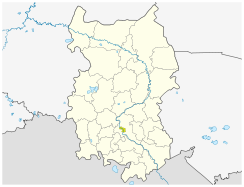 Omsk
|
|
| Coordinates: | |
 |
 |
| Holiday | First Saturday of August |
| Administrative status | |
| Country | Russia |
| Federal subject | Omsk Oblast |
| Administrative center of | Omsk Oblast |
| Municipal status | |
| Urban okrug | Omsk Urban Okrug |
| Mayor | Viktor Shreyder |
| Representative body | City Council |
| Statistics | |
| Area | 573 km2 (221 sq mi)[1] |
| Population (2002 Census) | 1,134,016 inhabitants[2] |
| - Rank | 7th |
| - Density | 1,979 /km2 (5,130 /sq mi)[3] |
| Time zone | OMST/OMSST (UTC+6/+7) |
| Founded | August 2, 1716 |
| Postal code(s) | 644xxx |
| Dialing code(s) | +7 3812 |
| Official website | |

Omsk (Russian: Омск) is a Russian city located in southwestern Siberia and the administrative center of Omsk Oblast. It is Russia's second-largest city east of the Ural Mountains. The distance from Omsk to Moscow is 2,700 kilometres (1,700 mi).
In imperial times, Omsk was the seat of the Governor General of Western Siberia, and later of the Governor General of the Steppes. For a brief period during the Russian Civil War in 1918–1920, it served as the capital of the anti-Bolshevik Russian State and held the imperial gold reserves.
Omsk is the administrative centre of Siberian Cossack Voisko, it also serves as the see of the bishop of Omsk and Tara, as well as the administrative seat of the Imam of Siberia.
Contents |
Location
Omsk is situated on the banks of the north-flowing Irtysh, at its confluence with the smaller Om River. The city has an altitude of 87 metres (285 ft) above sea level.
Both branches of the Trans-Siberian railway pass through the city, which also serves as a major junction for the regional highway network. River port facilities handle both passengers and freight, giving the city access to the extensive navigable waterways of the Irtysh and Ob rivers. The waterways connect Omsk with the coal and mineral-mining towns in Kazakhstan, as well as with the oil, natural gas and lumber operations of northern Siberia. Omsk is served by the Tsentralny Airport, which offers access to domestic and international (primarily, German and Kazakh) destinations, making the city an important aviation hub for Siberia and the Russian Far East.
Climate
The climate is dry and continental, characterized by dramatic swings of weather. The average daily temperatures, taken over the past three decades, are 20 °C (68 °F) for July and −19 °C (−2.2 °F) for January, although temperatures can reach 45 °C (113 °F) in the summer and drop to −45 °C (−49 °F) in the winter. On average Omsk sees over 300 sunny days in any given year. Average annual rainfall is 315 millimetres (12.4 in).
History
In 1714 Peter the Great sent Ivan Bukholts (Johann Buchholz) up the Irtysh to Lake Zaysan to search for gold and build a fort. They were driven out by the Oirats and retreated downriver to Omsk. The wooden fort of Omsk was erected in 1716 to protect the expanding Russian frontier, along the Ishim and the Irtysh rivers against the Kyrgyz nomads of the Steppes. In the late 1700s, stronger works of brick were erected on the right bank of the Om; of these, the original Tobolsk and the restored Tara gates still stand, along with the original German Lutheran Church, an armoury, a military jail, and commandant's house.
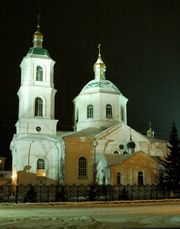
In the 19th and early 20th century, Omsk became the administrative center of Western Siberia and the Steppes (Kazakhstan), acquiring a few churches and cathedrals of various denominations, mosques, a synagogue, the governor-general's mansion, a military academy. Ink was joked to have been sold by the buckets. As the frontier receded and military importance diminished, the town fell into lethargy; it was during the mid-1800s that Dostoevsky lived and wrote in exile here.
The new boom began with the construction of the Trans-Siberian railway in 1890s, when the merchants flocked to the city on the rail/river junction. Many a trade companies opened stores and offices here, building an elaborately decorated district of the city, and bringing the hustle-and-bustle of modern transportation, means of communications and entertainment. Foreign powers, including the British, Dutch and Germans, opened consulates to represent their commercial interests. The pinnacle came with the lavish Siberian Exposition of Agriculture and Industry in 1910, for which a complex of buildings and fountains was constructed. In line with the popularity of World Fairs of the day, the exposition influenced observers to foretell the wonders of the "Chicago of Siberia". Many of the period's buildings survive (though none from the expo), and the architecture gives the city centre a distinguished historical Siberian town flavour.
Shortly after the 1917 revolution, the pro-monarchy "white" forces seized control of the city. The "Provisional Government of Russia" was established in 1918, headed by the polar explorer and decorated war hero Admiral Kolchak. Omsk was proclaimed the Capital of Russia, and its central bank kept the Imperial gold reserves, guarded by the Czechoslovakian garrison trapped in the chaos of World War I. The city proved to be a key to power in Siberia; eventually, Kolchak, the government, and the gold retreated along the Trans-Siberian eastward to Irkutsk, and the bolshevik "red" forces took control in 1919.
Soviet era
The Soviet government preferred the young Novonikolayevsk, now Novosibirsk, to be the designated centre of Western Siberia, prompting the mass transfer of administrative, cultural and educational functions from Omsk, dampening the city's growth and sparking a rivalry between the two cities continuing to this day. It was during and after World War II that Omsk received a new boost: many industries were evacuated away from Russia's western front in 1941. In the event of a German victory during the Battle of Moscow, Omsk was to become the provisional Soviet capital. However, the concentration of military enterprises also had negative effects, as until 1990, the city stayed closed to foreigners, and, after 1990, the collapse of the Soviet military demand led to high unemployment.
Military industries which moved here included part of the OKMO tank design bureau in 1941, and S.M. Kirov Factory no. 185 from Chelyabinsk, in 1962. The Kirov Factory and Omsk Transmash design bureau (KBTM) produced T-80 tanks from the 1970s, and were responsible for the BTR-T, TOS-1, and prototype Black Eagle tank. Omsk Transmash declared bankruptcy in 2002.
In the 1950s, following the development of oil and natural gas field in Siberia, an oil-refining complex was built, along with an entire "town of oilworkers", expanding Omsk northward along the Irtysh. It is currently the largest complex in Russia, and third such in Europe. Gazprom Neft, the parent company, is the largest employer in the city, wielding its tax address as leverage in negotiations with municipal and regional authorities.
Political Life
Following the collapse of The Soviet Union, Omsk experienced a period of economic instability and political stagnation. Most of the city's large businesses, which had previously been state owned, were fought over by members of the former party elite, the emerging nouveau riche, and the fast growing criminal syndicates. The most notorious cases involved the privitisation of Sibneft, a major oil company, which dragged on for several years. Until the end of the 1990s, the political life of the city was defined by an ongoing feud between regional and the municipal authorities. The resulting conflict made at least two points of view available to the public and served as the impetus for some improvements to the city's infrastructure and cultural life, including the construction of new leisure parks and the renovation of the city's historic downtown, the establishment of the annual Siberian International Marathon, and of the annual City Days Festival. Despite this, political infighting drained the city's resources and served as a major obstacle to smooth government operation and city development. The conflict was finally resolved in favor of the regional government with the forced resignation of two consecutive mayors and the subsequent de facto appointment of their successor by the regional governor. Since the turn of the century, the regional government has been firmly in control of Omsk's government, courts and media. The city is currently an underperformer, by Russian standards, in both economic growth and quality of life.
On March 2, 2005, the Consulate General of the Republic of Kazakhstan was opened. Previously in 1943, the Free India Government in Exile had opened its consulate in Omsk. Additionally, both Germany and Slovakia maintain honorary consuls in the city.
Culture and Points of Interest

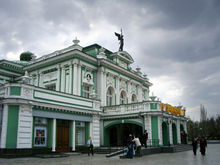
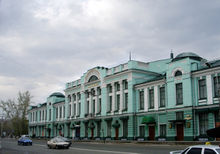
The centrepiece of the city is an ensemble of buildings along Lyubinsky Avenue/Lenin Street, anchored by the former Gostiny Dvor, and flanked by two chapels. The downtown area is an eclectic mix of architectural styles, with the area around Lyubinsky Avenue dominated by Art-Nouveau, Neoclassical and Second Empire. The Drama Theatre gives a good example of the latter. Soviet Era additions run the gamut from Constructivist, to Stalinist to Brutalist.
Closer to the confluence of the Om' and the Irtysh are the few surviving somber buildings of the 18th-century fortress. The largest and most opulent church in the city is the Dormition Cathedral, a five-domed edifice in the Russian Revival style, consecrated in 1896, demolished by the Soviets, and meticulously restored in the early 2000s.
Another area of interest is Nikolsky Prospekt/Krasnykh Zor Street, where a line of merchants' wooden houses still stands. The street leads to the Neoclassical cathedral of St Nicholas, which was commissioned by the Cossacks, designed by Vasily Stasov and consecrated in 1840. It contains various relics of the Siberian Cossacks.
Omsk is home to several museums, both minor and major:
- The Museum of Regional History
- The Dostoyevsky Museum of Literature
- Vrubel Museum of Fine Art
- The Military Museum and Memorial Complex
- The Art of Omsk Gallery
- The Kondratii Belov Museum
- The Liberov Museum of Art
- The Museum of Education
- The Museum of the Dramatic Arts
- The Airtrafic Museum
- The Kvadrat Gallery
- The Museum of the Dormition Cathedral
- The Museum of Puppetry
- The Flora Exposition Centre.
- The Dom Prirody Museum of Natural History.
- The Omsk Zoological Park
Demographics
The population in Omsk rose from 31,000 in 1881 to 53,050 in 1900 and to 1,148,418 in 1989 Census. The 2002 Census recorded that the population declined to 1,134,016.
The Omsk Metro
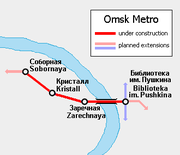
A subway system, proposed in the late 1980s, but postponed for lack of funds, is currently under construction, with the Metro bridge over the Irtysh river. The bridge is already opened for cars (upper level), but the metro (lower level) is still under construction. As a first step one short line will connect the districts in the northwest with the city centre. The first line of the metro is scheduled to be finished in 2010.
Sports
- Avangard Omsk is an ice hockey team, 2004 National champion, based in Omsk, playing in the Kontinental Hockey League. The team recently acquired former New York Rangers and Pittsburgh Penguins two time Stanley cup winner Jaromir Jagr.
Notable citizens
- Fyodor Dostoyevsky, Russian writer and essayist, lived there in prison exile from 1849-1854.
- Vikentii Trofimov, Russian painter lived there from 1924 to 1932.
- Yegor Letov, Russian punk rocker born and died there.
- Vlada Roslyakova, Russian supermodel was born there
- Eduard Kunz, Russian pianist was born there
Athletes
- Irek Gimayev was a member of the Soviet national hockey team who won the Challenge Cup and the 1981 Canada Cup.
- Nastja Ryjikh-Reiberger, 1999 pole vault indoor world champion
- Yuri Shatalov, was a member of the Soviet national hockey team who played in the Summit Series.
- Svetlana Karpeeva, 400m and 200m Individual Medley Olympic Swimmer winning several FINA world cup titles
- Dmitri Sychev, football player.
- Irina Tchachina, rhythmic gymnast.
- Evgeniya Kanaeva, rhythmic gymnast.
- Galima Shugurova, rhythmic gymnast.
- Aleksei Tishchenko, boxer.
- Dennis Siver, Mixed Martial Arts Fighter.
Education
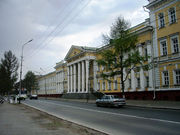
Omsk is home to many institutions of higher learning and several universities:
- ANO - Institute of Economics and Energetics
- AKSI - Aksenov Institute of Law and Economics, West Siberian department
- Law and Economics Institute
- Omsk Academy of Law
- Omsk Academy of MVD Rossija
- Omsk Aviation Technical School
- Omsk Foreign Language Institute
- Omsk Medical Academy
- Omsk State Transport University (1961)
- Omsk State Agrarian University (1918) (connected with Omsk State Veterinary Institute and Institute of Agribusiness and Continuing Education)
- Omsk State Pedagogical University
- Omsk State University (1974)
- Omsk Institute of Consumer Service Technology
- Omsk State Technical University (1942)
- SibADI - Siberian State Automobile and Highway Academy
- SibGUFK - Siberian Academy of Physical Culture
- Siberian Institute of Business and Information Technology
- Sovremennyi Gomunitarnyi University
- SIBNFOR - Siberian Stock Market Institute
International relations
Twin towns — Sister cities
Omsk is twinned with:
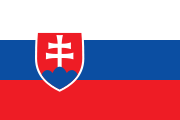 Puchov, Slovakia
Puchov, Slovakia Karlovy Vary, Czech Republic
Karlovy Vary, Czech Republic Kaifeng, People's Republic of China
Kaifeng, People's Republic of China Jinju, South Korea
Jinju, South Korea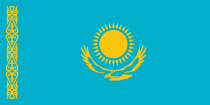 Petropavl, Kazakhstan
Petropavl, Kazakhstan Pavlodar, Kazakhstan
Pavlodar, Kazakhstan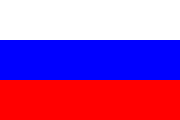 Novosibirsk, Russia
Novosibirsk, Russia Kaliningrad, Russia
Kaliningrad, Russia Chelyabinsk, Russia
Chelyabinsk, Russia Milwaukee, United States
Milwaukee, United States Ontario, Canada
Ontario, Canada York Region, Canada
York Region, Canada
Honors
- The 3406 Omsk asteroid, which lies in the main asteroid belt, is named after the city.[4] Furthermore, in 1997, Bella Alekseevna Burnashova, the discoverer of the asteroid, "presented" it to the mayor of Omsk, effectively making it the city's most outlying district.
References
- ↑ admomsk.ru
- ↑ Федеральная служба государственной статистики (Federal State Statistics Service) (2004-05-21). "Численность населения России, субъектов Российской Федерации в составе федеральных округов, районов, городских поселений, сельских населённых пунктов – районных центров и сельских населённых пунктов с населением 3 тысячи и более человек (Population of Russia, its federal districts, federal subjects, districts, urban localities, rural localities—administrative centers, and rural localities with population of over 3,000)" (in Russian). Всероссийская перепись населения 2002 года (All-Russia Population Census of 2002). Federal State Statistics Service. http://perepis2002.ru/ct/html/TOM_01_04_1.htm. Retrieved 2009-08-19.
- ↑ The value of density was calculated automatically by dividing the 2002 Census population by the area specified in the infobox. Please note that this value may not be accurate as the area specified in the infobox does not necessarily correspond to the area of the entity proper or is reported for the same year as the Census (2002).
- ↑ Dictionary of Minor Planet Names - p.284
External links
- Official website of Omsk city administration
- RMX.ru, Open Omsk, an independent news source
- Nomer.org, Omsk On-Line telephone directory
- Omsktime.ru, Current events in Omsk (Russian)
- Blogspot.com, Photoblog about Omsk
- Univer.omsk.su, Omsk-On-Line
- Omsk in Livejournal.com (Russian)
|
||||||||||||||
|
|||||||||||||||||||||||||||||||||||